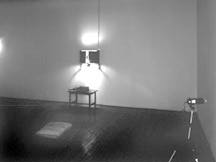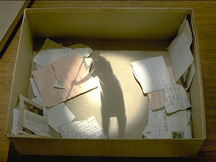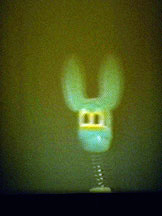- MAIN INDEX | ARTIST INDEX
| September 28 - October 28, 1995 Euan MacDonald and Heidi Kumao
| |
 Euan MacDonald, installation view of "Cracker", 1995. Photo Peter MacCallum. 18K | |
 Heidi Kumao, "Kept", 1993. Photo Peter MacCallum. 18K |  Euan MacDonald, "Cracker", 1995. Photo Peter MacCallum. 18K |
| Media Release Mercer Union is pleased to present an exhibition of works by Toronto artist Euan MacDonald and New York artist Heidi Kumao. Both artists employ projections as the main visual component of their current work. MacDonald projects computer animation and drawings, adapting images to specific sites. Kumao employs projections as central images in mixed media pieces, fusing film, photography, kinetics and sculpture. Through sequential images and repetition, MacDonald and Kumao present oscillating landscapes of the human condition. MacDonald explores technology and its ability to alter the meaning of images while Kumao, through her Cinema Machines, pushes technology to expose authoritative conditions which shape habits and societal forms of control. Euan MacDonald is represented by The Robert Birch Gallery.
Brochure Text: [Words for art. Tap in tune out.] Remember T.V.? Remember how the giant used to ask you, yes you (not millions of other viewers), to look up, way up...into his world of stories and fake companions. Real puppets. That was after he made a spot for you with toy chairs in front of the fireplace. Real comfortable. But nobody was there. All fake. I liked the intro to that show. I want to produce something similar here. Something you'd like ... something to introduce the imagination.
It's the feeling that counts. The details count. [Scene: Mercer Union, Saturday July 7, 1995. Researching the work. Oh oh, I'm way off. In slides, Euan's work looks very serious, sinister even, and Heidi is American--she won't know The Friendly Giant and her work has nothing to do with metaphoric references to Cultural-Content-slash-hugeness. Or does it?] Heidi and Euan; I imagine the show. Merging technologies from different periods, digital and analogue, electronic and mechanical. Stories told at a distance. An exact confusion. The distance of a return, a reviewing. That kind of distance. A common darkness. Plato's cave. A recounting in the distance, a physical narrative: light flares, travels in space, marking space. Making distance sound. Telling the tension of space and light...visible light, light as substance not as illuminator. Reminder. A visual narrative of moving pictures. The projections, screens, monitors, walls. Absorb. [One week later] Heidi. I saw the video of your kinetic works. Animation. Past and present. Zoetropes: early cinematography, the beginning of film, the search for motion. Heightened mimesis. Today, nostalgic contraptions that speak their function, their promise, their illusion, and perhaps their seduction. Witnessing the technology of early animation is a research, searching another time, memory. Bits of the deeply personal intersect with the historical; they meet, a synchronous displacement. Cultural Content: the past in the present. Recaptured anxiety. Repetition. Childhood pain/pleasure reviewed through a lens, mirrors, static bits projected, freeze framed, in light, enlight, in motion. Textured. References to the 1950's. Hand-me-downs. Memorabilia. Watching these gestures staged, anachronistic: so utterly obvious in how they work, so transparent, bare, obscure. Stuttered, sputtering. Childhood Rituals: Consumption, 1991-1993. That choice of image--sputtering, choking--cycle/recycle. Whose compulsion? Have your cake and eat it too. Eat My Shit. Eat Your Shit. Abject. Abjection: expulsion at the source of production: seen as necessary for growth. What is reproduced? What comes out at the other end? Am I losing you? Let me try again. Cyclical images run their course ending where they began--leading where? Good question. In how you may notice the light piercing through the darkened gallery? Where it hits the solids, meets a frame. Framed just so. You are framed. I am framed by my own connections to this work. My imagined pain. My compulsions. Animated in borrowing this light, in walking through it, in my confusion. In the exhausted beauty of it. Pleasure. Did I tell you? I can't remember. Kept, 1993. But I step back, I protest: That is not my mother sweeping clear an emotional space for communication--sweeping so compulsively that the opening is swept away, filled in by an outline of her. Why do I see it that way? Who is she, who keeps her? You? Why step back? Perhaps it is my unknowing entrance into where I draw the line. Where are my boundaries? Where do they reside on the outside? How can someone else point to my line but gesture in a direction that is both vague and precise? Transparent and obscure. A referencing. Euan. I went to your studio to look at your work. Tripods, mini projectors, computer animation; I take the equipment for granted even though it is still a mystery to me. Then you turned it on. Video and computer technology in the service gestures.Humour. I laughed so hard I couldn't really stop. It was a little things really. The exactness of the pencil head toy: its specificity, its ridiculousness, its snippet of richness. Its need; its function. Play with me. I told you my Friendly Giant story: the way the toy chairs were situated just so, on was a rocker and the giant's enormous hand would make it rock; then the camera panned to his boot, big boot, and his voice would beckon to look up, way up, the journey up his leg was time for excited expectation, a mood change, things were possible up there where the giant's head was. But you didn't know The Friendly Giant--and in the telling, I had second thoughts about the excited expectation of moving up this man's leg week after week. Have I lost my context?
I told you another story: I remember when I became too old for The Friendly Giant. I became sophisticated; I knew the ploy and was no longer engaged by it. Like figuring out Santa Claus, the Tooth Fairy, and the Easter Bunny--a little bit of miracle surrenders to the mundane. And I think I am so adult. A small corner of my mind is not so proud, an ache I do not confront. Now, I return to what ached me and find my sense of humour, my imagination, that unbored curiosity. A delicious sense of the ridiculous. Your Cracker piece does that to me. And Campfire reminds me of the intro to The Friendly Giant, my reference. Your work digs at the inside. Leaving the topsoil there, upturned. You circle around the idea of beginnings. Can this futility be seductive? Beginnings are so specific. I return again and again and still lose my way, or tell it differently. Beginnings are so huge. A rebirth in each movement of the same. Much of the time I'm indifferent to the miracle of it. That's how I saw the men in Leverage the first time around. I saw transformation and indifference, side by side. A simple narrative. Futile really. What happens when repetition is flipped over and tickled in the stomach? Loops. Loopy loops. Serious, funny, odd, persistent.
| |